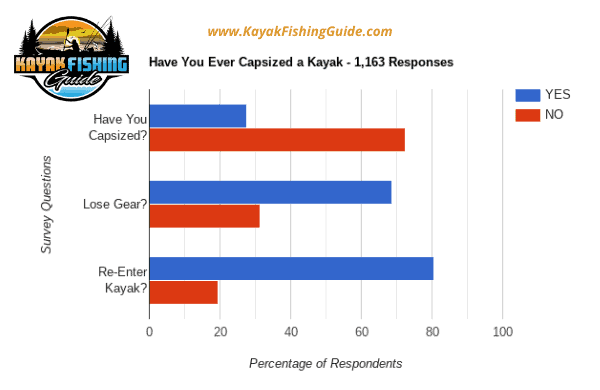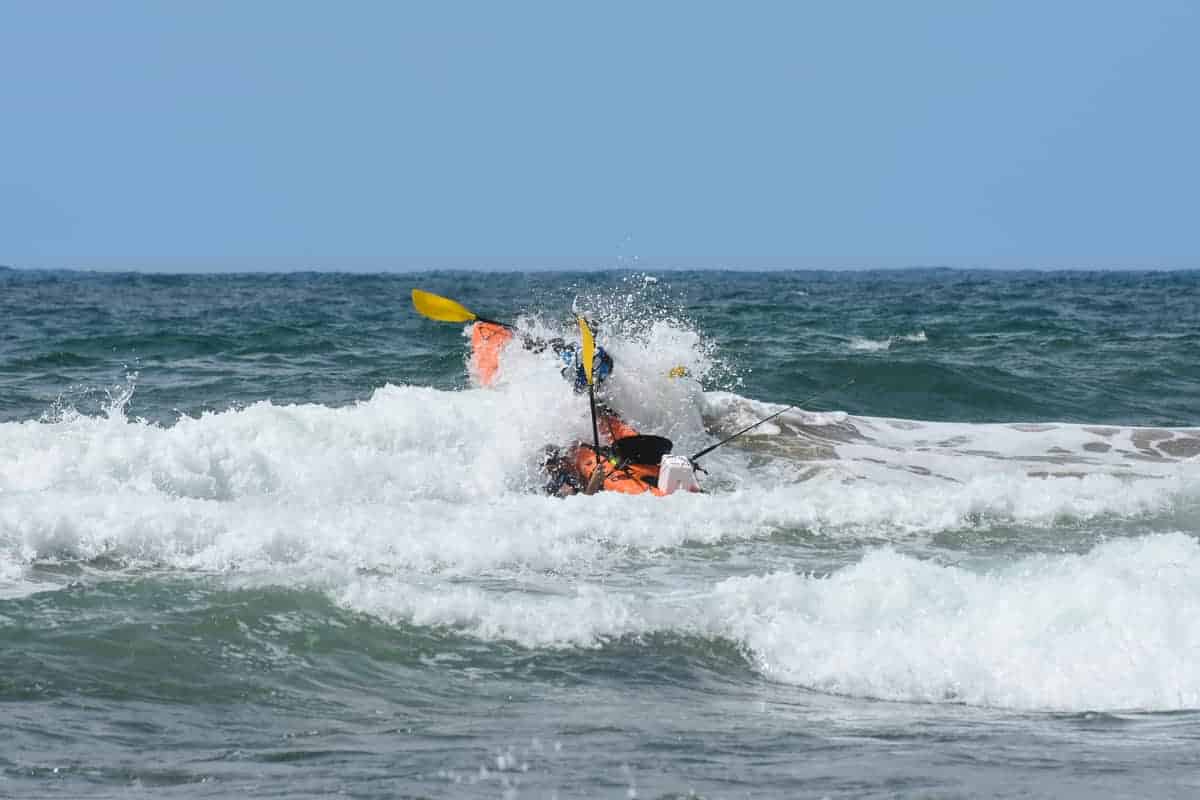Being on a large body of water in a fishing kayak may sometimes seem daunting. It certainly was when I first began fishing from a kayak! One of the more common questions people have is how easy it would be for a kayak to flip over!
With normal use and standard practices, kayaks are not prone to easily capsizing. Variables such as current, wind, surf, and weight distribution within the kayak are contributing factors. Modern kayaks are better designed, built with lighter materials, and with wider hulls to lessen overturning.
Nowadays, kayaks, especially fishing kayaks, are safer than ever! When used properly and with common sense, the chances of flipping your kayak over are less than ever. Let’s take a look at these survey numbers!
1,163 Kayak Fishermen Surveyed
Recently, I received 1,163 responses from kayak fishermen in different regions to a survey about whether they have ever flipped over or capsized their kayaks, and the results may surprise you!
Fishing from a kayak is actually a very safe activity, as you’ll see!

A numerical breakdown of the survey is as follows:
- 27.5% Had capsized or flipped their kayaks
- 72.5% Had never capsized or flipped their kayaks
- 68.7% Had lost some or all of their fishing gear
- 31.3% Had not lost any of their fishing gear
- 80.5% Were able to re-enter their kayak
- 19.5% Were not able to re-enter their kayak
As you can see from above, just about 1 in 4 kayaks will flip or capsize for some reason. What was super interesting were the stories they shared that accompanied the survey!
Three Common Causes of Kayaks Capsizing
Over 150+ comments were written by those who responded to the survey. After reading through them, a general theme began to materialize! It was the actions of the person who initiated the capsizing! The kayak didn’t flip over easily from its own accord!
Jumping feet first into a standing kayak isn’t the best way to enter your kayak, but the kayak can and will likely flip over if you attempt the maneuver! And yes, this happens!
Becoming complacent, lackadaisical, or too comfortable in your kayaking abilities can make you capsize.
Here are the three most brought-up reasons for having a fishing kayak flip over…
1. Reaching for a Dropped Rod or To Grab a Fish
The single most common reason for how a kayaker flipped while fishing was leaning too far outside the kayak’s centerline.
Two chief reasons were the cause of this.
- I accidentally dropped an expensive fishing rod over the side, instinctively leaned over, and tried to reach it before it sank out of sight.
- Bringing a large fish to the kayak side and leaning over to either net or hand-land the fish to bring it in.
Kayaks are very stable when used properly. Be aware of your centerline. Also, keeping most of your weight inside the kayak will keep you drier and longer!
For more information on kayak stability, take a look at the article: How Stable Is a Fishing Kayak?
Using a fishing rod leash is one way to keep your rods safe from falling overboard and to the bottom of the water. They are a very popular and cost-effective accessory fishermen use the Paddle Leash with a 2-Rod Leash Set from Amazon!
2. Having a Fish Pull You Over
This happens more frequently when fishing for larger offshore fish like Cubera Snapper, Roosterfish, Giant Trevally, and Dorado. However, freshwater gamefish like Muskie, Flathead Catfish, and northern pike can flip a kayak, too!
This happens when you’re fighting a large fish, and it swims to the side of your kayak. Now, you’re both pulling against each other from the side of the kayak.
The kayak is more stable from front to back rather than side to side. And with the pull coming from the side, the hull will roll toward the fish, and you now have a higher chance of flipping over!
To see a video showing a kayak flipping while fighting a fish, check out my other article: The Best Length Rod for Kayak Fishing – 5 Tips!
Always keep your rod tip pointed toward your kayak’s bow (the front). This will ensure that all the pressure is along the full length of the hull, giving you plenty of stability and allowing you to remain in control of your kayak!
3. Caught in the Current or Surf
The third most common way of having your kayak flip over and capsize is getting caught up in the current or surf.
Caught in the Currents
When you’re in a moving waterway like a river or stream, the current can trap you against a log or another obstruction.
You lose the ability to control your kayak, and it turns sideways to the current. Either the water is swept beneath the log, or the kayak floods.
Even when you’re anchored far below a spillway dam, and the water is calm, the current picks up drastically if they begin to let more water downstream.
Pulling in your anchor against this rising current can become difficult, and water will sweep over the bow, flooding your kayak. At this point, you will need to cut your line to free yourself from the anchor line.
Learn more about safety knives: Best Kayak Fishing Safety Knife? (My #1 Pick)
Caught in the Surf
The surf can be just as unforgiving to the kayak crowd, too!
Whether you are coming in or heading out into the surf, once the force of any wave turns you sideways, no matter how small, you’re at the mercy of the water!
The surf then begins to push you into the shore, turns you sideways to the force of the wave, and your kayak rolls over. Not once, but maybe several times until you get to water shallow enough to stop it.
Do Kayaks Tip Over Easily
Kayaks are designed not to tip over easily. Today’s kayaks are wider and more stable than earlier models. With wider hulls, better materials, and sit-on-top kayaks becoming more popular, you’ll find it difficult to tip one over! Recreational and fishing kayaks are safer than ever!
How To Stop Your Kayak From Flipping
To keep your kayak from flipping, exercise good judgment and always try to remain in a good seated position.
Even though 72.5% of those responding to my survey indicated they had never flipped or capsized, you will want to keep your body centered in the kayak as much as possible.
Don’t lean over the sides too far, as this will also cause the kayak to lean. Once this rolling action begins, many people will panic and overreact, causing the kayak to roll over into the water.
Kayaks are designed to be a stable platform for fishing or recreational activities. It’s when people push the limits of the kayak that they get into trouble.
If you have an older model kayak or your current kayak doesn’t feel as stable as it should, you might want to consider adding on aftermarket pontoons!
YakGear Gen 2 Kayak Outriggers
The YakGear Kayak Outriggers provide extra stability for your kayak, making fishing more secure and enjoyable. These durable, easy-to-install outriggers keep your kayak steady in rough waters or when reeling in big catches. Perfect for anglers who want a more stable platform without sacrificing maneuverability.
These pontoons attach to your kayak and keep it from rocking back and forth. They’ll also allow you to stand up and sight cast to fish if desired!
Pro Tip: The YakGear Generation 2 Kayak Outriggers on Amazon will give you the ultimate stability with adjustable pontoons!
What To Do if Your Fishing Kayak Flips
Most people do not practice flipping their kayak and getting back in so they are comfortable with it. So what happens is, when you finally do capsize your kayak, it will most likely be the first time.
Your safety is the primary concern if your fishing kayak were to flip! If your kayak flips over, anchor lines can get loose, rods and their leashes may hang, and all of these can entangle you. Don’t worry about saving your gear until you have the upright kayak and are safely back aboard!
The important thing is to get away from any hanging lines that may entangle you and impede your ability to either get back into the kayak or swim away!
Related article: Dealing With A Sinking Fishing Kayak
According to the survey above, 19.5% reported they could not right the kayak and climb back in! That means 1 in 5 people were in the water and couldn’t get out.
Most of them swam to shore and then rescued their kayak and gear once they were better rested either by themselves or with the assistance of others.
You may have invested a lot of money in expensive gear, but as we all hear, it can be replaced. Don’t be concerned about it; your personal safety is paramount!
Why Your Kayak Is Unstable
Your kayak may be unstable for a variety of reasons.
Keeping the weight distribution low and as centered as possible will increase your stability many times over. Having heavy gear, anchors, or coolers strapped to the edges or near the outside of the kayak will decrease the stability.
A top-heavy kayak is more likely to be unstable and capsize without warning.
Having too much weight in the kayak will cause it to be highly unstable! Always go by the ‘Weight Capacity Rating’ of your particular kayak!
You can read more about weight capacity and why it’s important here of you like! Kayak Weight Limits Explained for Larger Anglers
Is a Wider Kayak More Stable
Narrow kayaks lack the Secondary Stability that gives the wider hull kayaks their lateral stability.
Wider kayaks are more stable than their narrower counterparts. Fishing kayaks are generally wider across the hull than other recreational kayaks, giving them more side-to-side stability, known as Secondary Stability. A wider kayak hull will result in a more stable kayak.
Give the article How Wide Is a Fishing Kayak? a quick look for additional information on the stability of fishing kayaks!
Overall, we have learned that most kayakers have yet to flip over or capsize. And most of the incidents are due to operator error, misjudging conditions, or just doing something goofy!

Practice! Practice! Practice!
One of the best things you can do is practice getting in and out of your kayak while on the water.
Keep in mind that it isn’t if you’ll capsize one day. It’s when you do. Will you be ready?
Start in a relatively shallow depth of water where you can easily stand up or reach shore if need be.
Empty your kayak with all your gear and paddle out a short way. Grab a good hold of the rail and lean over until you flip it.
Right the kayak, reach across to the other side, and pull yourself in.
There is no better time to get wet and attempt to get back into your kayak than when you set the time! Don’t get caught in the cold or bad weather conditions to make your first attempt at getting into your kayak!
Have fun, and stay safe out there!

